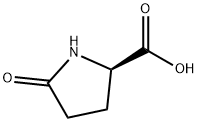| Identification | More | [Name]
D-Pyroglutamic acid | [CAS]
4042-36-8 | [Synonyms]
2-PYRROLIDINONE-(R)-5-CARBOXYLIC ACID
5-OXO-D-PROLIN
5-OXO-D-PROLINE
D-5-OXO-2-PYRROLIDINECARBOXYLIC ACID
d-5-pyrrolidone-2-carboxylic acid
D-GLUTAMIC ACID LACTAM
D-PROLINE, 5-OXO-
(+)-D-PYROGLUTAMIC ACID
D-PYROGLUTAMIC ACID
D-PYR-OH
H-D-PGLU-OH
H-D-PYR-OH
(R)-(+)-2-PYRROLIDINONE-5-CARBOXYLIC ACID
(R)-2-PYRROLIDINONE-5-CARBOXYLIC ACID
(R)-(+)-2-PYRROLIDONE-5-CARBOXYLIC ACID
(R)-2-PYRROLIDONE-5-CARBOXYLIC ACID
(R)-(+)-5-OXO-2-PYRROLIDINECARBOXYLIC ACID
(R)-5-OXO-2-PYRROLIDINECARBOXYLIC ACID
(R)-5-OXOPYRROLIDINE-2-CARBOXYLIC ACID
(R)-5-PYRROLIDONE-2-CARBOXYLIC ACID | [EINECS(EC#)]
223-735-0 | [Molecular Formula]
C5H7NO3 | [MDL Number]
MFCD00066212 | [Molecular Weight]
129.11 | [MOL File]
4042-36-8.mol |
| Chemical Properties | Back Directory | [Appearance]
white to light yellow crystal powde | [Melting point ]
155-162 °C
| [alpha ]
27.5 º (c=10,1N NaOH) | [Boiling point ]
239.15°C (rough estimate) | [density ]
1.3816 (rough estimate) | [refractive index ]
10 ° (C=5, H2O) | [storage temp. ]
Store at 0-5°C | [solubility ]
Dimethylformamide, DMSO (Slightly), Methanol (Slightly), Water | [form ]
Solid | [pka]
3.48±0.20(Predicted) | [color ]
Off-White to Light Beige | [optical activity]
[α]22/D +10°, c = 1.5 in H2O | [Water Solubility ]
soluble | [Usage]
Serves as a building block in the synthesis of diphthamide | [Detection Methods]
Rotation,T,NMR | [Merck ]
8001 | [BRN ]
82133 | [InChIKey]
ODHCTXKNWHHXJC-GSVOUGTGSA-N | [CAS DataBase Reference]
4042-36-8(CAS DataBase Reference) |
| Safety Data | Back Directory | [Hazard Codes ]
Xi | [Risk Statements ]
R36/37/38:Irritating to eyes, respiratory system and skin . | [Safety Statements ]
S26:In case of contact with eyes, rinse immediately with plenty of water and seek medical advice .
S36:Wear suitable protective clothing .
S37/39:Wear suitable gloves and eye/face protection . | [WGK Germany ]
3
| [HS Code ]
29337900 |
| Hazard Information | Back Directory | [Description]
D-Pyroglutamic acid, also known as 5-oxo-D-proline, is a metabolite of D-glutamate. It is formed from D-glutamate by D-glutamate cyclase. The levels of D-pyroglutamic acid are increased in the urine of patients with nascent metabolic syndrome and the plasma of patients with end-stage renal disease. | [Chemical Properties]
white to light yellow crystal powde | [Occurrence]
D-pyroglutamic acid is formed by the dehydration between the α-NH2 group and the γ-hydroxyl group of glutamic acid to form an intramolecular amide bond; it can also be formed by the loss of an amide group in the glutamine molecule. | [Uses]
Serves as a building block in the synthesis of diphthamide | [Definition]
ChEBI: D-Pyroglutamic acid is the D-enantiomer of 5-oxoproline. It has a role as a metabolite. It is a D-proline derivative and a 5-oxoproline. It is a conjugate acid of a 5-oxo-D-prolinate. It is an enantiomer of a 5-oxo-L-proline. | [reaction suitability]
reaction type: solution phase peptide synthesis | [Biological Activity]
D-Pyroglutamic acid (PCA) is a cyclic derivative of glutamic acid, physiologically present in mammalian tissues. It has been shown that PCA releases GABA from the cerebral cortex and displays anti-anxiety effects in a simple approach-avoidance conflict situation in the rat. In clinical pharmacology experiments, PCA significantly shortens the plasma half-life of ethanol during acute intoxication. | [storage]
Store at -20°C | [Purification Methods]
Purify R-pyroglutamic acid by dissolving it in H2O, filtering, passing the filtrate through Dowex 50 (H+ form), washing with H2O, pooling washings, evaporating, removing H2O azeotropically with Me2CO and *C6H6, washing the residue with Et2O and recrystallising from EtOH/pet ether. [Pradeller et al. Collect Czech Chem Commun 42 79, 80 1977, Beilstein 22/6 V 7.] | [References]
1. Ariyoshi, M., Katane, M., Hamase, K., et al. D-Glutamate is metabolized in the heart mitochondria. Sci. Rep. 7, 43911 (2017). DOI:10.1038/srep43911
2. Shim, K., Gulhar, R., and Jialal, I. Exploratory metabolomics of nascent metabolic syndrome. J. Diabetes Complications 33(3), 212-216 (2019). DOI:10.1016/j.jdiacomp.2018.12.002
3. Palekar AG, et al. Accumulation of 50oxo-L-proline and 5-oxo-D-proline in the blood plasma in end stage renal disease. Biochem Med. 1975 Nov;14(3):339-45. DOI:10.1016/0006-2944(75)90052-6
4. D-Pyroglutamic Acid Production from L-Glutamic Acid by Successive
Racemization, Resolution and Dehydration. DOI:10.6967/JCICE.200003.0177 |
|
|





